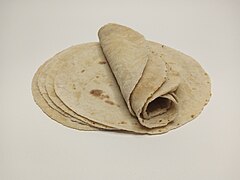
Back روتي (خبز) Arabic روتى ARZ ৰুটী Assamese रोटी Bihari আটার রুটি Bengali/Bangla Roti (pokrm) Czech रोटी DTY ރޮށި DV Roti Spanish نان روتی Persian
 flat roti, also known as chapati | |
| Alternative names | Ruti |
|---|---|
| Type | Flatbread |
| Place of origin | Indian subcontinent[1][2][3] |
| Created by | Indus Valley civilization[1] |
| Main ingredients | Atta flour |
| Variations | Chapati, Bajra Roti,[4] Jowar Roti, Chawal ki Roti Makki ki roti, Rumali roti, Tandoori roti, Wrap roti, Roti canai, Paratha |
Roti (also known as chapati)[5] is a round flatbread originating from the Indian subcontinent. It is commonly consumed in many South Asian, Southeast Asian, Caribbean, and Southeast African countries.
It is made from stoneground whole wheat flour, traditionally known as gehu ka atta, and water that are combined into a dough.[6][7] Its defining characteristic is that it is unleavened. Naan from the Indian subcontinent, by contrast, is a yeast-leavened bread, as is kulcha. Like breads around the world, roti is a staple accompaniment to other foods.[5]
- ^ a b Alan Davidson (21 August 2014). The Oxford Companion to Food. OUP Oxford. pp. 692–. ISBN 978-0-19-104072-6.
- ^ Jim Smith (15 April 2008). Technology of Reduced Additive Foods. John Wiley & Sons. pp. 113–. ISBN 978-1-4051-4795-8.
- ^ Bruce Kraig; Colleen Taylor Sen (9 September 2013). Street Food Around the World: An Encyclopedia of Food and Culture. ABC-CLIO. pp. 301–. ISBN 978-1-59884-955-4.
- ^ Aroona Reejhsinghani (June 2004). Feast on a Diabetic Diet. B. Jain Publishers. ISBN 9788180560118.
- ^ a b Cite error: The named reference
Wrigley Corke Seetharaman Faubion 2015was invoked but never defined (see the help page). - ^ Davidson, A.; Jaine, T. (2014). The Oxford Companion to Food. Oxford Companions. OUP Oxford. p. 692. ISBN 978-0-19-104072-6. Retrieved 9 February 2018.
- ^ Zahid, Anusha (9 October 2017). "Sunridge launches into atta". Aurora Magazine. Retrieved 9 February 2018.
© MMXXIII Rich X Search. We shall prevail. All rights reserved. Rich X Search